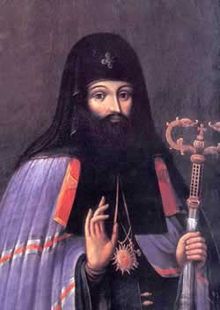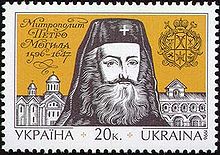- Peter Mogila
-
Petro Mohyla 
Metropolitan of Kiev and Halych Born December 21, 1596
Suceava, MoldaviaDied December 22, 1646 (aged 50)
Kiev, UkraineHonored in Ukrainian Orthodox Church[disambiguation needed  ], Romanian Orthodox Church, Polish Orthodox Church
], Romanian Orthodox Church, Polish Orthodox ChurchFeast January 1, but also October 5 Metropolitan Peter (secular name Pyotr Simeonovich Mogila, Russian: Пётр Симеонович Могила, Ukrainian: Петро Симеонович Могила, Romanian: Petru Movilă; 21 December 1596 – 22 December 1646) was a Metropolitan of Kiev, Halych and All-Rus' from 1633 until his death. He was born into a Moldavian boyar family — the Movileşti — one that gave Moldavia and Wallachia several rulers, including his father, Ieremia Movilă. His mother, Margareta, was a Hungarian noble lady. From his early childhood, Petro Mohyla and his mother were on the move in foreign lands seeking refuge due to instability in Wallachia (part of modern-day Romania). For a time, they lived in Kamianets-Podilskyi in Ukraine. But in 1608 they moved to Poland and for sixteen years stayed in Stanisław Żółkiewski's castle.[1] There he started his formal schooling, which, prior to the arrival to the castle, was often interrupted by frequent moves. Petro’s teachers were monks from the Lviv brotherhood and later, he continued his studies of classical literature in Latin, Greek, Polish, and Ukrainian languages at the academy in Zamość (the Zamojski Academy), founded in 1594 by Polish Crown Chancellor Jan Zamoyski. Later Mohyla continued his studies in Paris.
Contents
Career
In the 1620s, Mohyla traveled to Ukraine which at that time was in a political turmoil due to internal and external factors, in part due to Poland’s annexation of Ukrainian lands. He settled in Kyevo-Pechers’ka Lavra in Kiev (Kiev Pechersk Lavra), which was the political, cultural, spiritual, and educational center of Ukraine. There he joined Ivan Boretsky, Zakhariy Kopystetsiy, and Pamvo Berynda, and a group of scholars and orthodox clerics who promoted ideas of national liberation and cultural self-preservation. The effects of political instability had an impact on all spheres of life in the country. The number of printed publications was significantly reduced and many schools were closed. In order to preserve their privileges before the Polish king, the nobility, in great numbers, started to convert from Orthodoxy to Catholicism.[2]
 Moldovan stamp
Moldovan stamp
In 1632 Mohyla became the bishop of Kiev and abbot of Pecherska Lavra. Because of his ties to several European royal homes, the leadership of the Orthodox clergy entrusted him to negotiate with the Polish Sejm (parliament) and the king to lift the repressive laws against the Orthodox Church and to ease the restrictions on the use of the Ukrainian language in schools and public offices. Mohyla’s diplomatic talent paid off. King Władysław IV reinstated the status of the Ukrainian Orthodox Church.[3] The first years as abbot Mohyla showed that he had far-reaching goals to reform not only the monastic life at the Lavra and the Church. He wanted to strengthen the Orthodox spirituality and enhance the sense of national identity as well as raise the educational level in the country to equal that in Western Europe.
One of the first steps in implementing this vision, Mohyla founded at the Lavra a school for young monks (1632).The tutoring was conducted in Latin. The students studied theology, philosophy, rhetoric, and classical authors. At the same time, Mohyla significantly improved the print shop at the Lavra where Orthodox books were published in Latin and distributed to various places in eastern Europe. Later that year, Mohyla merged this school with the Kiev Brotherhood school and created the Mohyla collegium which later became known as the Kyiv Mohyla Academy (National University of Kyiv-Mohyla Academy).[4] The students at the collegium had diverse backgrounds. They came from noble, clerical, gentry, Cossack and peasant families. The school offered a variety of disciplines: Ukrainian, Latin, Greek, and Polish languages; philosophy; mathematics, including geometry; astronomy; music; and history. Because of the high profile of the faculty, the collegium received the status of a higher educational establishment.
In the next few years, Mohyla established a whole network of schools around Ukraine as well as the Slavonic-Greek-Latin Academy in Vinnytsia and collegium in Kremenets. Also, he supplied the prince of Wallachia, Matei Basarab, upon his request, with a printing press and printers. In 1635 the prayer books which were published in Prince Basarab’s monastic residence were widely distributed in Wallachia, Romania, and Ukraine.
Printing
For over 20 years, Mohyla played a leading role in Ukraine’s book printing. He was one of the first to print in the Ukrainian language. Mohyla and his followers at the Lavra and the Mohyla collegium made the first steps in formulating the fundamentals of the modern Ukrainian language. The proliferation of the Ukrainian language in print was part of a wider effort of Ukraine’s struggle for sovereignty and cultural self-preservation. Mohyla wanted to preserve the Ukrainian nation’s identity that had been experiencing enormous pressure from the Polish and Russian regimes. He initiated the publication of sermons for the laity in Ukrainian, Biblical texts in Church Slavonic, and scientific books in Ukrainian, Polish, Greek, and Latin. Mohyla wrote several books which were distributed in Ukraine, Poland, Muscovy, Wallachia, Romania, and Georgia. One of his most important publications was Catechesis (1640). After it was approved by several Ecumenical Patriarchs of Constantinople it became the foundational document for the Church doctrine in the orthodox world.[5] During the 17th and 18th centuries, this book had 25 editions. His other notable works included Trebnyk or Euchologion (1646). It resembled an encyclopedia in which all Ukrainian church rites and services were systematized. Also a decade earlier, he published his Anthologion in which he emphasized the need for teachers to find unique approaches to each student when teaching since their abilities varied. Applying the same requirements to all students may not be the most effective teaching method. Mohyla stressed the need for students to ponder over and understand and not simply repeat scientific, religious, and moral truths.[6] In this and other works, Mohyla underscored the need for the younger generation to use their minds and not emotions in striving to achieve goals. In his Triodion (1631), Mohyla expressed his political views about what an ideal ruler should look like. He argued that the person has to maintain peace with the neighbors; defend his lands in the times of war; a ruler is not only obligated to issue laws but first of all he should limit his own powers.
Legacy
Mohyla’s innovative approach in reforming the education system by introducing Latin in the curriculum of schools and universities met some resistance when Russian loyalists resorted to violent acts against teachers and educational facilities where Latin was taught. However, Mohyla remained undeterred in his efforts to make the use of Latin in schools obligatory since it was an essential part in the curriculum in all European schools and universities. One of Mohyla’s main arguments in favor of Latin was that students who learn it in Ukraine would have an advantage should they decide to continue their studies in other European universities, since Latin was practically the lingua franca of the scholarly world.
Historic preservation was another aspect of Mohyla’s multifaceted career. He initiated substantial restoration projects of key historical monuments in Kiev and around the country. Among them was the Saint Sophia Cathedral in Kiev. People believed that for as long the Cathedral was standing the city would be spared from destruction. Thus by restoring St. Sophia and other monuments, Mohyla, on the one hand, strengthened the Ukrainian Church’s position, and on the other, his efforts were a morale booster for the whole country at a times when national unity and independence were at risk.[7]
Petro Mohyla died in 1647, on the eve of the national liberation war of 1648-1654. In his testament, he instructed that all his property be given to the Mohyla collegium which for nearly two centuries remained the only higher education establishment in the Orthodox world. Just as Petro Mohyla’s envisioned, the school became an important scientific, educational, cultural, and spiritual center of Ukraine. Its graduates propagated ideas of humanism and national self-determination. Many of them pursued their careers in Western Europe but many traveled the countryside and taught in villages and towns. According to the Christian Arab scholar Paul of Aleppo, who in 1655 traveled through Ukraine to Moscow, “Even villagers in Ukraine can read and write …and village priests consider it their duty to instruct orphans and not let them run in the streets as vagabonds.”[8]
Thus Petro Mohyla is credited with laying the foundation for a cultural epoch which historians call the Mohyla period. One of the attributes of this epoch was book publication. Despite the political instability in Ukraine in the late 1600s, it had 13 printing presses, of which 9 were Ukrainian, 3 Polish, and 1 Jewish. The output of these presses was not only of a religious nature. For example, in 1679 the press in Novhorod-Siverski put out over 3 000 copies of various textbooks for elementary schools.[9] This was a tremendous achievement due in part to Mohyla’s efforts to spread literacy among all social groups.
Sainthood
He is venerated as a saint in the Ukrainian Orthodox Church[disambiguation needed
 ], the Russian Orthodox Church and the Romanian Orthodox Church and the Polish Orthodox Church. His feastday is January 1, but is also commemorated October 5 together with the other sainted Metropolitans of Kiev.
], the Russian Orthodox Church and the Romanian Orthodox Church and the Polish Orthodox Church. His feastday is January 1, but is also commemorated October 5 together with the other sainted Metropolitans of Kiev.Honours
- National University of Kyiv-Mohyla Academy in Kiev is named after Petro Mohyla
- St. Petro Mohyla Institute in Saskatoon, Canada, is named after him.
Sources
- Українська педагогіка в персоналіях – ХІХ століття / За редакцією О.В. Сухомлинської / навчальний посібник для студентів вищих навчальних закладів, у двох книгах// «Либідь», - К., 2005, кн. 1., стор. 100-110
- Довідник з історії України. За ред. І.Підкови та Р.Шуста. — К.: Генеза, 1993.
- Гайдай Л. Історія України в особах, термінах, назвах і поняттях. — Луцьк: Вежа, 2000.
- Orest Subtelny, Ukraine: A History, University of Toronto Press, 1988
References
- ^ Українська педагогіка в персоналіях – ХІХ століття / За редакцією О.В. Сухомлинської / навчальний посібник для студентів вищих навчальних закладів, у двох книгах// «Либідь», - К., 2005, кн. 1., стор. 100
- ^ Ibid., 102
- ^ Ibid., 103
- ^ Ibid., 105
- ^ Ibid., 106
- ^ Ibid., 107
- ^ Ibid., 109
- ^ Orest Subtelny, Ukraine: A History, University of Toronto Press (1988), p. 155
- ^ Orest Subtelny, Ukraine: A History, University of Toronto Press (1988), p.156
-
- Inline:
-
- General:
 This article incorporates text from a publication now in the public domain: Chisholm, Hugh, ed (1911). Encyclopædia Britannica (11th ed.). Cambridge University Press.
This article incorporates text from a publication now in the public domain: Chisholm, Hugh, ed (1911). Encyclopædia Britannica (11th ed.). Cambridge University Press. This article incorporates text from a publication now in the public domain: Jackson, Samuel Macauley, ed (1914). "article name needed". New Schaff-Herzog Encyclopedia of Religious Knowledge (third ed.). London and New York: Funk and Wagnalls.
This article incorporates text from a publication now in the public domain: Jackson, Samuel Macauley, ed (1914). "article name needed". New Schaff-Herzog Encyclopedia of Religious Knowledge (third ed.). London and New York: Funk and Wagnalls.- Petro Mohyla in the online Encyclopedia of Ukraine
Preceded by
Isaia KopynskyMetropolitan of Kiev, Galychyna and All-Rus'
1633–1646Succeeded by
Sylvester KossovCategories:- 1596 births
- 1646 deaths
- Metropolitans of Kiev and all Rus'
- Ukrainian Orthodox metropolitan bishops
- Romanian Orthodox bishops
- Theologians
- Ukrainian people
- Eastern Orthodox saints
- University and college founders
- Ukrainian saints
- Romanian saints
- Polish saints
- Russian saints
- Ukrainian people of Romanian descent
- 17th-century Christian saints
- Orthodox bishops of the Polish–Lithuanian Commonwealth
Wikimedia Foundation. 2010.

